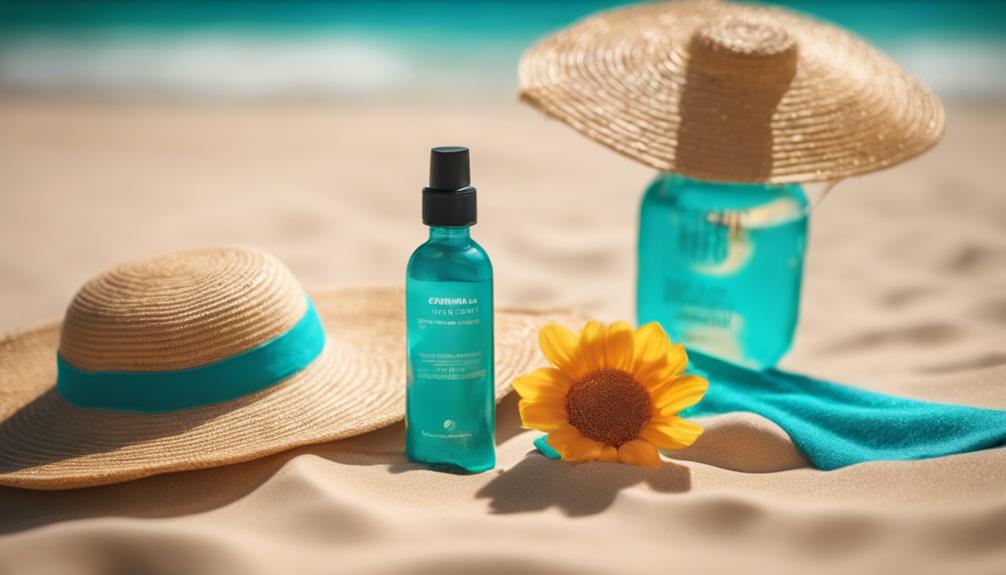To optimize your tan, it is important to space out tanning sessions based on your skin type, ensuring proper recovery and hydration. For example, those with Type I skin should limit sessions to once every 7-10 days, while Types II to VI can tan more frequently, ranging from every 2-7 days. Allow at least 48 hours between sessions to give the skin time to heal and retain moisture. Following a good skincare routine and staying hydrated will also improve your tanning results. Developing personalized tanning strategies can significantly enhance your experience and outcomes.
Key Takeaways
- Customize tanning frequency based on your skin type to avoid damage and enhance results.
- Allow a minimum of 48 hours between sessions for optimal skin recovery and hydration.
- Gradual tanning sessions reduce burn risk and promote a more even tan.
- Stay hydrated by drinking water daily to support skin health and improve tanning outcomes.
Skin Type Awareness
Understanding your skin type is fundamental for developing an effective and safe tanning strategy, as it directly influences your skin's tolerance to UV exposure and the potential for achieving a desirable tan.
The Fitzpatrick Scale classifies skin types from I to VI, ranging from those who burn easily to those who tan deeply. This classification helps determine the appropriate tanning approach; for instance, individuals with Type I skin should avoid extensive UV exposure, while those with Type II can achieve a tan with careful management.
Indoor tanning can be utilized across skin types, but personalized strategies are essential to minimize risks and enhance results.
Adequate hydration and gradual tanning sessions are crucial for peak skin health and tanning success.
Melanin and Tanning Process
Melanin production is an essential factor in the tanning process, as it not only provides skin pigmentation but also serves as a natural defense against UV damage.
The tanning mechanism involves the stimulation of melanocytes, which are specialized cells responsible for melanin synthesis. When skin is exposed to UV rays, these cells increase melanin production, resulting in a darker skin tone.
Proper melanin oxidation is important for achieving a gradual tan; hastening this process can lead to skin burns and damage. Understanding the nuances of melanin production allows individuals to customize their tanning routines effectively, ensuring safety while maximizing results.
Therefore, a well-informed approach to melanin dynamics is crucial for achieving a desirable and lasting tan.
Session Frequency Guidelines

Determining the appropriate frequency of tanning sessions is essential for achieving ideal results while minimizing the risk of skin damage. Tanning should be customized based on skin type and sensitivity, ensuring a gradual approach to prevent burns. The following table outlines recommended session frequencies for different skin types:
| Skin Type | Recommended Frequency |
|---|---|
| Type I | 1 session every 7-10 days |
| Type II | 1 session every 5-7 days |
| Type III | 1 session every 3-5 days |
| Type IV-VI | 1 session every 2-3 days |
Consulting with tanning professionals can provide tailored recommendations, enhancing both safety and effectiveness. Gradual increases in session frequency allow skin to adapt, optimizing results while protecting skin health.
Importance of Recovery Time
Recovery time between tanning sessions is essential for allowing the skin to heal, maintain hydration, and enhance the overall effectiveness of the tanning process. A minimum of 48 hours is recommended, as this period enables the skin to repair itself and build melanin, leading to a richer, deeper tan.
Gradual exposure not only minimizes the risk of burns but also maximizes tanning results. Additionally, it is vital to pay attention to skin signals, as both insufficient rest and overly extended breaks can hinder progress.
Hydration and Skin Care

Maintaining proper hydration and skin care practices is essential for supporting skin health and enhancing the tanning process, particularly after allowing adequate recovery time between sessions. Hydrated skin not only promotes a more even tan but also reduces the risk of irritation and peeling.
| Hydration Tips | Moisturization Practices | Skin Care Products |
|---|---|---|
| Drink plenty of water daily | Use a rich moisturizer | Aloe vera gel for soothing |
| Limit caffeine and alcohol | Apply post-tan lotion | Sunblock with adequate SPF |
| Eat water-rich foods | Reapply moisturizer regularly | Tanning accelerators |
| Avoid hot showers | Use products with antioxidants | Gentle exfoliants |
| Maintain a consistent routine | Focus on dry areas | Non-comedogenic formulas |
Incorporating these strategies can greatly enhance the tanning experience and promote healthier skin overall.
Safe Tanning Practices
Implementing safe tanning practices is vital to minimize skin damage while achieving a desired tan.
First, understanding your skin type is important; those with fair skin should limit exposure to prevent burns.
Gradual tanning sessions are recommended, allowing the skin time to adapt and recover. A minimum of 48 hours between sessions is advisable to facilitate skin repair and melanin production.
Additionally, always use appropriate sun protection, such as broad-spectrum sunscreens, even during tanning.
Staying hydrated and moisturizing the skin pre- and post-tanning further enhances skin health and promotes an even tan.
Resources for Effective Tanning

Utilizing extensive resources can greatly enhance the effectiveness of your tanning regimen by providing tailored guidance based on individual skin types and preferences. Accessing reputable sources guarantees safe practices, ideal session timings, and product recommendations, considerably improving tanning results.
| Resource Type | Description |
|---|---|
| Online Guides | Thorough articles on skin types and tanning techniques. |
| Professional Consultation | Expert advice from tanning salon professionals. |
| Tanning Products | High-quality lotions and tan extenders for enhanced results. |
| Community Forums | Platforms for sharing experiences and tips from fellow tanners. |
Incorporating these resources into your tanning routine can lead to a more effective and safer tanning experience. Always prioritize skin health and educated choices for the best outcomes.
How Can I Space Out My Tanning Sessions to Maximize My Tan?
To maximize your tan, it’s important to space out your tanning sessions according to the perfect tanning durations. This means giving your skin enough time to recover between sessions to avoid burning and overexposure. Generally, 48-72 hours between sessions is recommended for the best results.
Conclusion
To sum up, maximizing tanning results necessitates an awareness of skin type, an understanding of melanin production, and a commitment to strategic session spacing.
Prioritizing recovery time, maintaining hydration, and adhering to safe tanning practices emerge as crucial elements in achieving a radiant glow while safeguarding skin health.
By integrating these principles, individuals can foster not only a beautiful tan but also a sustainable approach to skin care, ensuring long-term health and resilience against sun damage.










